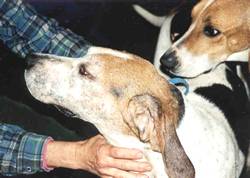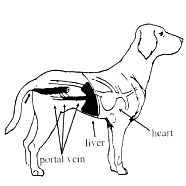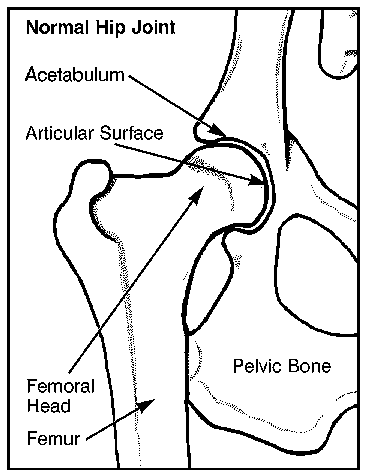Health Issues
![]()
Cerebellar Ataxia:
 In
1998, a hereditary condition called Cerebellar Ataxia, hereafter referred to as CA, was
acknowledged in the Spinone Italiano, with the first suspect cases appearing in
1990. There is no treatment and it is always fatal. To date, all the
cases reported have been under one year of age. CA appears to be restricted to one
family line only and all cases reported to date have one or more of the proven
carriers on both sides of the pedigree. Please visit the Spinone Club of
America's website for more up to date information.
In
1998, a hereditary condition called Cerebellar Ataxia, hereafter referred to as CA, was
acknowledged in the Spinone Italiano, with the first suspect cases appearing in
1990. There is no treatment and it is always fatal. To date, all the
cases reported have been under one year of age. CA appears to be restricted to one
family line only and all cases reported to date have one or more of the proven
carriers on both sides of the pedigree. Please visit the Spinone Club of
America's website for more up to date information.
Leishmaniasis:
 At the National meeting of the Spinone Club of America, an
announcement was made that Visceral leishmaniasis had been found in Spinone.
Leishmaniasis is an infection of dogs and humans with the protozoan parasites of the
Leishmania donovani complex; it is usually spread by the bite of an infected sand fly and
in dogs is normally fatal.
At the National meeting of the Spinone Club of America, an
announcement was made that Visceral leishmaniasis had been found in Spinone.
Leishmaniasis is an infection of dogs and humans with the protozoan parasites of the
Leishmania donovani complex; it is usually spread by the bite of an infected sand fly and
in dogs is normally fatal.
Aortic Stenosis:
Aortic Stenosis has recently been found in the Spinone. While it is believed to be a hereditary problem, more information needs to be gathered before we can determine which lines are carriers. There is an excellent article written on Aortic Stenosis written by Dr. Cathy Priddle.
Liver Shunt:
 While liver shunts are not common in Spinone,there have been reported
cases, therefore, it must be included here. The official name is Portosystemic
Shunt. It is an abnormal connection of the blood vessels which connect the portal
vein to the systemic circulation. It is believed to be an inherited disorder. The
clinical signs are a result of toxins in the blood (energy loss, weight loss
and diarrhea. They include but are not limited to disorientation, seizures,
pacing and coma.
While liver shunts are not common in Spinone,there have been reported
cases, therefore, it must be included here. The official name is Portosystemic
Shunt. It is an abnormal connection of the blood vessels which connect the portal
vein to the systemic circulation. It is believed to be an inherited disorder. The
clinical signs are a result of toxins in the blood (energy loss, weight loss
and diarrhea. They include but are not limited to disorientation, seizures,
pacing and coma.
Ectropia:
The word Ectropia is derived from the Greek word "Ectropion" meaning an inside -out eye. It is the result of the lower lid turning outward exposing the inner surface of the lid resulting in irritation. It is a common genetic condition in a number of breeds, however it is not commonly found in Spinone. Another condition, loose lower lids, have sometimes been mistaken for Ectropia, however true ectropia in Spinone is relatively rare. There is an excellent article on loose lids called "The Eyes Have It" written by Norm Prima.
Canine Heatstroke:
HEATSTROKE is the most common and most often fatal syndrome in dogs. It is associated with exposure to high temperature and humidity and very poor ventilation. Heatstroke develops rapidly, high fever must be reduced rapidly to save a dog's life and prevent permanent brain damage. Body temperature of 106° and above can be tolerated only a few minutes before irreversible damage occurs to the central nervous system.
Hip Dysplasia:
 Canine
Hip Dysplasia is a relatively common disorder in veterinary medicine. The
highest incidence occurs in larger, rapidly growing dogs. The effects can range from
mild to severe, resulting in euthanasia for animals severely affected. There is an
excellent article written by Cheryl
Minnier.
Canine
Hip Dysplasia is a relatively common disorder in veterinary medicine. The
highest incidence occurs in larger, rapidly growing dogs. The effects can range from
mild to severe, resulting in euthanasia for animals severely affected. There is an
excellent article written by Cheryl
Minnier.
Canine demodecosis is an inflammatory parasitic disease of dogs, characterized by the presence of a high number of mites on the hair follicles, which often leads to a secondary bacterial infection. The mite, Demodex canis, is a part of the normal funna of canine skin and is normally preset in small numbers. The mite resides in the hair follicles and sebaceous gland of the skin. Pathologic changes develop for the mite infestation when numbers exceed that tolerated by the immune system.
There are two types of Demodex infestations: localized and generalized.
Localized cases occur in young dogs usually going though puberty. This can happen anywhere from 3-18 months old. It is a mild case, usually on the face. Patches of hair lost can also occur on the limbs or trunk of the body. Most cases (90%) resolve spontaneously with no treatment. This is not a genetic problem.
Generalized cases can occur in young or old dogs. It is a severe disease that causes hair loss all over the body. As hair follicles become distended with large numbers of mites, secondary bacterial infections are common, often with rupturing of the follicles. Dogs with generalized demodex must be dipped regularly to try and kill the excessive mites. In the worst cases, the dog would have to be euthanized. These dogs are thought to have a poor immune system that is unable to fight off the excessive mites. These dogs are NEVER to be bred.